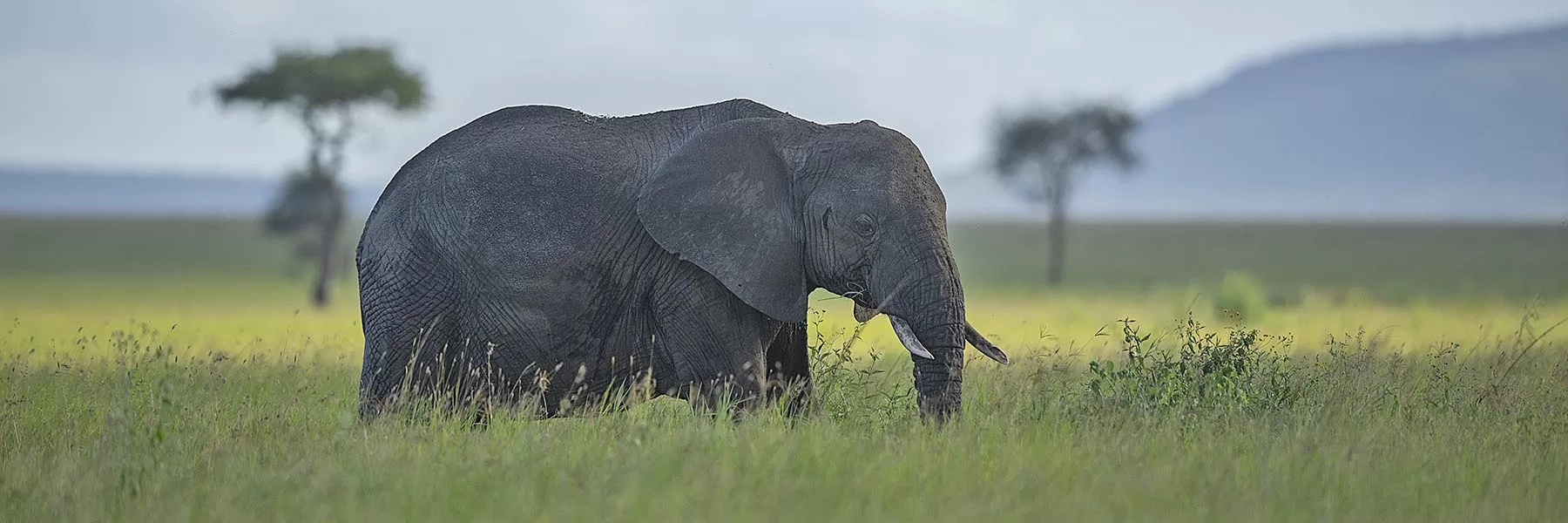Taking a trip to Serengeti National Park is a lifetime experience. Located in Tanzania, it is one of the oldest national parks in the country and a UNESCO Site. Serengeti National Park ranks amongst the most famous wildlife reserves on this planet and is synonymous with the word “African safari“, which we offer.
The park was established in the year 1952 and covers around 14,750 square km of grassland plains. This vast area flows into neighboring Kenya where it is called Maasai Mara. Once you enter the southern plains of the park, you can immediately sense the extensive landscape.
The word ‘Serengeti’ was given by the Maasai people which translates to ‘endless plains’. True to its name, it encompasses wildlife, flora, fauna, and iconic sights for the traveler.
Serengeti National park’s features have barely changed in the past millions of years. The ecosystem of the park has inspired many writers, filmmakers, photographers, and scientists.
Flora
Serengeti National Park is dominated by plants in the open savannah grasslands. As the park is closer to the Equator, it creates a direct impact on the climatic conditions. This determines the flora of the national park.
The uneven distribution of rain in various regions results in different species of trees.
 Acacia Tree
Acacia Tree
This uneven distribution is directly linked with the location of wildlife animals. Across the park, Black rhinos are found mostly in the North where vegetation is rich. The leopards can be seen in the Seronera areas that are filled with Acacia trees.
The park is comprised of woodland, grasslands, marshes, and plains. In this savannah, you find a mixture of various trees and grass. It is also home to many alien and unusual plant species which can only be found in Serengeti.
The trees offer food, shelter, and hunting territory for predators. The vast plant species attract different animals in Serengeti.
These are some of the notable species of flora found in Serengeti National Park:
Grasses
1. Pan Dropseed
Pan Dropseed comes from the Sporobolus ioclados species and is one of the dominant in short grass plain. What makes the Pan Dropseed distinctive from other grasses is its shape. The seed head of the pan appears to dangle like miniature ornaments.
 Pan Dropseed
Pan Dropseed
2. Red Oat Grass
Known by its scientific name Themeda triandra, it is called rooigras in Afrikaans. Red Oat Grass turns light pinkish and red color as it dries out.
This grass species is one of the dominant in woodlands and the long grass plains of Serengeti.
 Red Oat Grass
Red Oat Grass
3. Finger Grass
Finger Grass comes from the genus of Digitaria and is one of the most common grass you can find in Serengeti National Park. The leaves of the grass are preferred by grazers as it is palatable and nutritious.
As the name suggests, the Finger Grass seed looks like thin fingers pointing above or at the sky.
 Finger Grass
Finger Grass
Trees
1. Umbrella Trees
Umbrella Trees or Vachellia Tortilis is known to represent Africa with its signature shape on the flat landscape. The tree arches over savannah throughout the park and can be distinguished with striking white thorns, falt-top and dark bark.
Elephants and Giraffes favor the seedlings of this tree. Most of the umbrella trees in Serengeti National Park are 45 to 125 years old.
 Umbrella Trees
Umbrella Trees
2. Sausage Tree
Also known as Kigelia Africana, it is sparsely found in the park along the dry river banks. The tree grows long, succulent yet poisonous fruits that usually drop and release seeds.
The fruit stalks of the tree are often mistaken as the tail of a leopard.
 Sausage Trees
Sausage Trees
3. Yellow Fever-Tree
Yellow fever trees are commonly found in wet areas along the swamps, rivers, and floodplains. It gets its unique name from the early settlers who observed that malaria was recurrent while standing near the river. Rather than blaming the mosquitoes, they blamed the disease on the yellow trees that grew in the vicinity.
Yellow fever trees are tall and have white thorns, wide branches, and yellow bark which makes them distinctive.
 Yellow Fever-Tree
Yellow Fever-Tree
4. Commiphora
Commiphora can be seen throughout the Serengeti National Park but are more dominant in the Eastern section. They can be distinguished through their papery blue or yellowish bark and small round leaves.
One can make use of the roots, bark, and berries of the tree to make local medicine which proves helpful for several treatments like rashes and stomach aches.
 Commiphora
Commiphora
5. Wild Date Palm
This is one of the most common trees found along the banks of rivers and swamps in Serengeti. The fruit from Wild Date Palm is edible but the taste isn’t the most faltering. The sugary sap of the tree can be converted into palm wine.
The tree offers immense shade for resting lions.

Wild Date Palm
6. Whistling Thorn
Whistling Thorn is home to ants, providing food and shelter to them. The name of the tree is derived from the sounds of whistles that are made by ants.
Whistling Thorn appears as an odd-looking tree with hard and hollow spheres at the bottom of its thorns, encompassing biting ants.

Whistling Thorn
Mark this place for your bucket list as the journey to Serengtei National Park will remain in your memory for a lifetime.
If you loved reading this story, then subscribe to our blog here (it will ask to verify your email) to get inspiring travel stories and trivia delivered to your email. Stories about wildlife trivia, cultural experiences, curated luxury hotel lists, underrated places to travel, polar journeys and much more.











